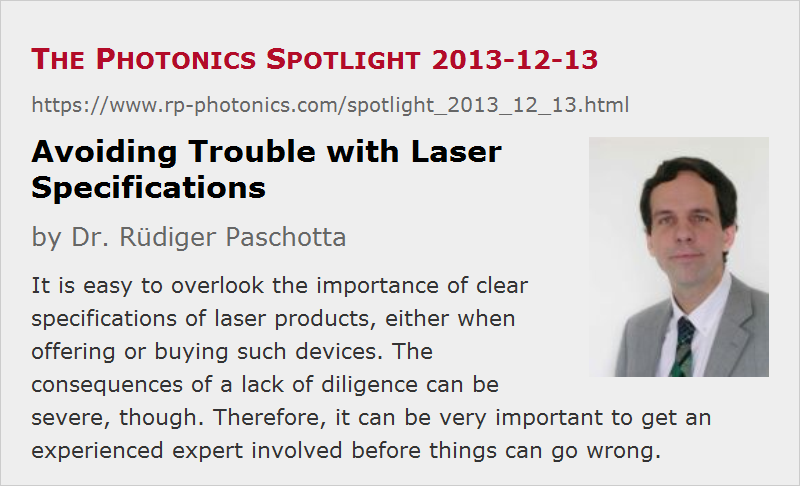Avoiding Trouble with Laser Specifications
Posted on 2013-12-13 as a part of the Photonics Spotlight (available as e-mail newsletter!)
Permanent link: https://www.rp-photonics.com/spotlight_2013_12_13.html
Author: Dr. Rüdiger Paschotta, RP Photonics Consulting GmbH
Abstract: It is easy to overlook the importance of clear specifications of laser products, either when offering or buying such devices. The consequences of a lack of diligence can be severe, though. Therefore, it can be very important to get an experienced expert involved before things can go wrong.

Ref.: encyclopedia article on laser specifications
Can you imagine how much trouble can arise from incomplete and unclear specifications of lasers? Apparently, most people cannot – otherwise, it would not be so common that such specifications are quite poor. And indeed a lot of bad things happen because people are too careless with specifications.
I recently had to form an expert opinion in a case where a multi-million dollar battle had developed. Different opinions on the exact meaning of certain laser specifications were at the heart of that conflict. Due to a substantial lack of clarity of these specifications, it required rather complicated work to clarify that in hindsight.
Note that the exact meaning of specifications is just one of the possible issues. Further questions can come into play:
- How strict do we have to be when judging such issues? As that is usually not defined in quotations, purchase orders and similar documents, one has to find a reasonable judgment based on various circumstances. For example, is it an industrial laser, a medical or scientific laser? Is it a prototype, where you have to be somewhat more tolerant, or a production machine?
- What shall happen if specifications are not fulfilled? A manufacturer may say: Well, we will just repair the device as often as necessary within the warranty period. An industrial user, however, may have great problems with that if such repairs are required too frequently – that may render the laser useless for the intended application.
What also makes it difficult is that there is often not a clear line between purely technical and legal issues. Obviously, legal expertise alone is not sufficient, but if you have a technical expert who finds it hard to understand certain legal principles, it may result in a difficult communication between him and the lawyers.
Of course, the very best thing is to avoid such trouble from the beginning by being very careful with laser specifications
- when you are a supplier, formulating specifications for your products, and
- when you want a buy a laser and need to formulate what exactly you need.
As always, those dealing with the matter may or may not be sufficiently competent for that. If not, it is very advisable to get an experienced external expert involved. That can avoid a lot of trouble, and costs a very tiny fraction of what is at stake. An employee might not be keen to tell his boss that additional external competence is required to be secure; however, he may be even less keen to report huge trouble as a consequence of a lack of diligence!
What you can ask an expert may be, for example:
- Systematically check the specifications (or more generally, the descriptions) of a certain range of products. Identify unclear details and suggest how to remedy them. Give warnings where problems may arise.
- Work out the detailed requirements on a laser for a certain application. Discuss with those who will apply the laser what exactly they want to do. Make them aware of possible issues. (Note that the end users are often not aware what specifications are vital for their application, as they don't know the challenges of laser development).
I am happy to do such jobs, which are particularly useful. Curiously, however, I am not often asked to do such things. I suppose this is because most people are not aware how important these matters are. Many buyers would not be willing to pay a little money for clarifying their requirements, and many suppliers don't seem to care that their published specifications make no good impression and invite trouble.
As a free but valuable piece of information, I offer my recently written encyclopedia article on laser specifications.
This article is a posting of the Photonics Spotlight, authored by Dr. Rüdiger Paschotta. You may link to this page and cite it, because its location is permanent. See also the RP Photonics Encyclopedia.
Note that you can also receive the articles in the form of a newsletter or with an RSS feed.
Questions and Comments from Users
Here you can submit questions and comments. As far as they get accepted by the author, they will appear above this paragraph together with the author’s answer. The author will decide on acceptance based on certain criteria. Essentially, the issue must be of sufficiently broad interest.
Please do not enter personal data here; we would otherwise delete it soon. (See also our privacy declaration.) If you wish to receive personal feedback or consultancy from the author, please contact him e.g. via e-mail.
By submitting the information, you give your consent to the potential publication of your inputs on our website according to our rules. (If you later retract your consent, we will delete those inputs.) As your inputs are first reviewed by the author, they may be published with some delay.
 |



If you like this page, please share the link with your friends and colleagues, e.g. via social media:
These sharing buttons are implemented in a privacy-friendly way!